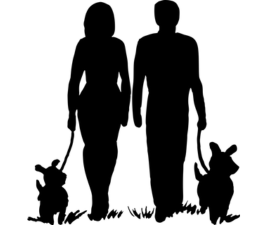Are you always face to face with your dog when you’re training?
Everybody does it. When you start teaching your dog anything, the dog is in front of you. You can see what they’re doing and where they’re looking. And they can see you. But there are not many times when that’s a useful place for your dog to be.
Translating front-focused behaviors to at-your-side isn’t easy. Chances are you have many repetitions built up with your dog in front of you. For your dog, that’s the most valuable place to be. It’s been rewarded a lot, so it gets repeated. A lot.
The result is that teaching a dog to walk nicely next to you, or “heel” in the proper position, is challenging. The dog always wants to keep an eye on your face, so they swing their butts out. Which results in a crooked walk, and a very crooked automatic “Sit.”
For most people it’s probably not a big deal. For those of us who want to play in dog sports like Obedience and Rally, it is a big deal. Every time your dog sits crooked, it’s points off your score.
Taking a cue from you
You’ve heard it from us a lot. What gets rewarded, gets repeated. To encourage your dog to stay nicely at your side, reward at your side. Pay attention to the “reward zone” – which should be the side of your leg closest to your dog. Our students constantly hear “Don’t reach to reward!” And never, ever reward from the hand that’s farther from your dog.

Reward with the hand closest to the dog. It’s a safety issue. Dogs aren’t stupid. They know which hand has the treats. And if it’s the hand farther away from them, they’re going to cross in front of you to get it. You’ll either kick your dog, trip over your dog, or stumble trying to avoid kicking/tripping over your dog. Rewarding with the hand near the dog is a safety issue, not a training one. Our usual phrase is “Your dog will trip you and kill you.”
Practicing all kinds of walking patterns is “noodling.” Expecting your dog to follow your movements while maintaining position at your side. Try left turns, right turns, 180 degree turns, backwards, to the right and left. If you watch videos of canine freestyle, you’ll see that even the most complex “dance” routines are mostly about the synchronized movement of dog and handler.
Building body awareness
Most dogs aren’t aware that their hind legs can operate independently of their front. In truth, they probably don’t even realize what’s back there or that they control it. It’s one of the reasons dogs chase their tails – they don’t really know it’s theirs. And when they catch it and bite it, they’re surprised it hurts.
Fostering whole-body awareness in your dog benefits them throughout their lives. Doing Perch Work, walking sideways and backwards, can all increase your dog’s fitness and mobility. It matters more as dogs age. Dogs are prone to arthritis and joint issues as they get older. And the old saw “Use it or lose it” holds true for dogs as well as people. The larger the dog, the more crucial it is to keep them moving. It’s possible to pick up a small dog to get them in the car, or transport them up and down stairs. If your dog is upwards of 50 lbs it’s much more difficult.
If you establish a little “workout” routine for your dog when they’re young and agile, even when they’re old and creaky they’ll still know how to do it. They may be slower, but the spirit will still be willing.
If you enjoyed this dog training tip, sign up here for our weekly email newsletter and never miss another tip!






